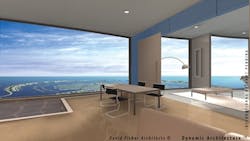Newsworthy: The Ultimate View
By Patricia Kirk
Italian architect David Fisher, principal at Milan firm Dynamic Architecture, has designed an energy-producing building he calls a "living machine" because it simulates living organisms, moving through time and space in a 360-degree rotation to provide occupants a complete view of their surroundings.
His design offers the ultimate in luxury, with a voice-activated mechanism that moves floors independently, allowing the view to change upon command. Hotel guests ordering room service, for example, could watch the sun rise over the mountains at breakfast and eat dinner overlooking the ocean without ever leaving their rooms. Floors rotate at less than 1 mile per hour, so slow movement is hardly noticeable, says Fisher, noting that at this rate, floors would make one revolution a day.
The idea for this innovative concept, dubbed "dynamic architecture," came to Fisher after a Miami developer noted the premium prices ocean-view condominiums command. Thinking about this on a flight from Miami to New York, he says, "That's when I said to myself, ‘Why not rotate the whole damn floor?' That takes very little energy."
While Fisher's concept is not new - there are plenty of rotating restaurants around - it takes this idea to the next level, offering an opportunity to create energy-independent, sustainable cities with skylines composed of shape-shifting buildings that are, in their own right, works of art. If built, this design could achieve both outstanding structural and technological feats: Facilities could offer improved seismic safety and generate their own energy, and a new construction approach could make it possible to build tall, modular skyscrapers.
Wind turbines placed horizontally in a 2-foot space between floors, rather than vertically, combined with photovoltaic panels on the roof or each floor, turn these buildings into power stations that produce sufficient energy to meet all the needs of occupants, with enough left over to power four or five other similar-sized buildings in the neighborhood.
"The wind turbines are positioned where power is needed, not 50 miles out," Fisher says, noting that unlike unsightly vertical wind turbines, his horizontal turbines are hidden in a 2-foot space between floors and can be accessed for maintenance via an elevator rather than using a ladder.
The first of Fisher's rotating buildings, dubbed The Da Vinci Tower, is under way in Dubai. This $350-billion, 78-story mixed-used project, with 300 hotel rooms, 200 to 300 apartments, and an undetermined amount of office space, will have 77 wind turbines, but 10 turbines at most will power the entire building, according to Fisher. "Wind exists and is free. If we sell [excess] energy to the neighbors, payback for the investment in wind turbines is about 2 years," he adds, noting that energy produced is estimated at a value of about $7 million annually.
Fisher and his engineering team, led by Leslie Robertson, best known for work on the World Trade Center in New York, have devised a top-down scheme for building modular skyscrapers. Until now, a barrier to building modular skyscrapers has been the 12-story reach of construction cranes. Consequently, developers have used modular units to get up to 12 stories, then have added on using traditional construction techniques.
But with this top-down approach, an elevator device attached to the central core lifts each of the 12 prefabricated modules comprising one floor to the top to be tied together, with each floor assembled in descending order until the ground level is reached.
Modules will be constructed in a facility in Jebel Ali, a port city 22 miles south of Dubai in the United Arab Emirates, under the high quality-control standards of a factory.
The only part of the tower that will be constructed on-site is a central concrete core that, similar to the human spine, provides great flexibility, making it 1.3 times more resilient to seismic shifts than most buildings. The concrete core, which remains stationary, will also house elevators for both people and automobiles, with parking available on each level.
Fisher believes that in the future all buildings will be prefabricated in factories because the method lowers labor costs and construction time. He estimates that modular building methods will reduce the on-site workforce for the Dubai building from 2,000 to about 90 workers and construction time from 30 to 18 months.
In addition to the buildings in Dubai, another is in the design phase in Moscow and others are proposed for Milan, San Diego, Boston, and Chicago, according to Fisher, who notes that while the same methods will be used to construct different buildings, each one will have a unique design.
Patricia Kirk ([email protected]) is a freelance writer based in Austin, TX.
